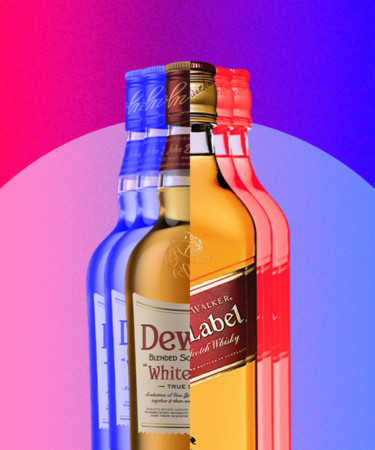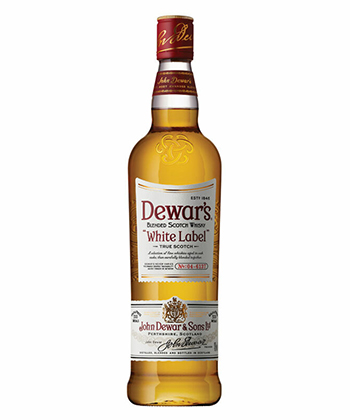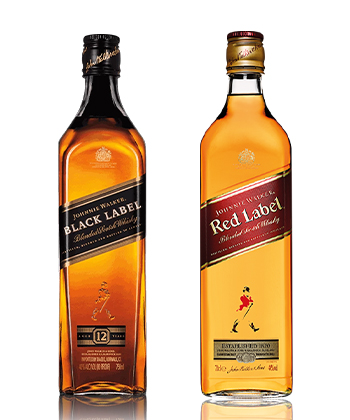Johnnie Walker, perhaps the most recognizable name in blended Scotch whisky, consistently takes the top prize as the world’s best-selling Scotch. Owned by spirits conglomerate Diageo, the company sold over 18 million cases alone in 2019, according to The Spirits Business.
Dewar’s, another ubiquitous brand in the category, sold 3 million cases in the same year. A subsidiary of Bacardi, Dewar’s flagship White Label is consistently lauded as America’s favorite single bottle of Scotch. Its Double Double 32 Year Old won Whisky of the Year in 2020, adding credence to its claim as “The World’s Most Awarded Blended Scotch Whisky.”
While even casual drinkers will recognize Johnnie Walker’s iconic bottle and slightly off-kilter label (angled at a precise 24 degrees), or have seen one of Dewar’s distinctive television commercials, there’s much more to these two brands. Whether you’re a longtime Scotch drinker or just dipping your toes into the category, keep reading to learn how these two classics stack up.
Origin
Established in 1846 by John Dewar, Dewar’s started as a family-run wine and spirits shop in Perth, Scotland. Following the passing of The Spirit Act, Dewar began blending his own whiskies, making his name synonymous with a mark of quality. Dewar died in 1880 and the business passed to his two sons, John Alexander and Tommy. Nearly two decades later, the brothers founded Aberfeldy Distillery, which would carry on the Dewar’s label.
Johnnie Walker’s foray into whisky also started in a shop; having opened up a grocery store after his father’s death forced him to sell his family farm. Located in the Scottish town of Kilmarnock, Walker’s store sold an ample supply of single malts. Bemoaning the lack of consistency in whisky of the era, Walker began blending his own.
As The Spirits Business writes, it wasn’t until after Walker’s death in 1857 that his son Alexander produced the company’s first blend, called “Walker’s Old Highland,” which would later be sold as the Red and Black Labels.
Production
Johnnie Walker Red Label, the company flagship, is bottled at 80 proof and blended with up to 30 single malts and grains, sourcing the blend’s peat-heavy whiskies from the Scottish west coast and lighter variants from the east. Also 80 proof, Johnnie Walker Black Label only includes whiskies aged for a minimum of 12 years.
Johnnie Walker Blue Label is a rare and premium blend made from hand-selected whiskies sourced from distilleries around Scotland. The style pays tribute to Walker’s Old Highland Whisky, and, according to the company, only one in every 10,000 casks of whisky are exceptional enough to be included.
Dewar’s foundational expression, White Label, clocks in at 80 proof and includes a blend of 40 different single malt and grain whiskies. Dewar’s touts its whisky as “double-aged,” meaning that it is aged once prior to blending and again after the perfect blend is derived. The rarest expression in the brand’s permanent line — Dewar’s 25 Years Old — is aged for a minimum of 25 years before being finished in casks from the Royal Brackla Distillery.
Flavor
When tasting the two, Matt Corbin, the beverage director at 7908 in Aspen, Colo., begins with “every Scotch drinkers’ favorite part — the nose.” Corbin describes Dewar’s White Label as exhibiting a complex combination of heather, Meyer lemon, stone fruit, and grapefruit, while the palate reminds him of “the first time I had Scotch with my great-grandfather — graham cookies, honeycomb, all in a bed of peaty goodness with some beautiful baking spices at the end, with sage, rosemary, and a little citrus.”
For Corbin, Johnnie Walker Black expresses aromas of “warm baking spices along with vanilla, followed by dried pineapple and a citrus oaky finish.” On the palate, it tastes “thick and rich with heather, a bright bouquet of baking spices, corn flakes, and Mary Jane Taffy-like notes with a light smoky and complex citrus finish.”
Use in Cocktails
Both companies tout their Scotch as the go-to in the Highball cocktail, a simple combination of whisky and sparkling water, served over ice. Dewar’s even claims the cocktail was invented by its own Tommy Dewar in 1892. Not to be outdone, Johnnie Walker recently launched a global campaign aimed at bolstering the brand’s role in the Scotch & Soda trend.
Why the Pros Like Each
Comparing each brand, Corbin considers their status as “two of the titans of blended Scotch whisky,” remarking that their universal popularity ensures they are easily found in bars around the world. But deciding a winner in this clash of titans was tough: “In one corner of the bar, we have a light, bright Scotch full of fond memories, [which] claims to have invented the Highball (still don’t believe that claim). In the other corner, we have the undisputed king of blended Scotch, full of rich history and pop culture shout-outs galore. I will definitely keep both of these fine spirits behind the bar, but the one I grab first will be Johnnie Walker Black.”


